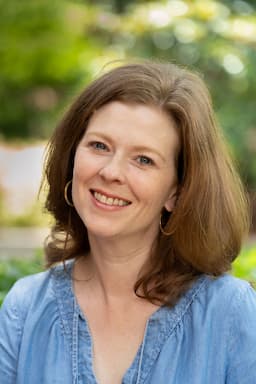The Mystics #3: Hildegard of Bingen
By Elizabeth Prata
Introduction
Julian of Norwich (1343 – after 1416) Book: The Showings of Divine Love
Catherine of Siena (1347 – 1380). Book: The Dialogue of St. Catherine of Siena
Hildegard of Bingen (1098 – 1179). Book: Scivias
Bridget of Sweden (c. 1303 – 1373) Book: Celestial Revelations
If you ever feel like you haven’t accomplished much, then definitely do not read about Hildegard von Bingen’s life!

Overview of Hildegard’s life: Wikipedia: She “was a German Benedictine abbess and polymath active as a writer, composer, philosopher, mystic, visionary, and as a medical writer and practitioner during the High Middle Ages. She is one of the best-known composers of sacred monophony, as well as the most recorded in modern history. She has been considered by many in Europe to be the founder of scientific natural history in Germany. … There are more surviving chants by Hildegard than by any other composer from the entire Middle Ages, and she is one of the few known composers to have written both the music and the words. One of her works, the Ordo Virtutum, is an early example of liturgical drama and arguably the oldest surviving morality play. She is also noted for the invention of a constructed language known as Lingua Ignota.” She also was elected Mother Superior of her abbey and founded two monasteries.
A polymath is defined as “a person of wide-ranging knowledge or learning.”
Wow! A superstar. A Renaissance woman before the Renaissance happened!
Just as with Catherine of Siena and Julian of Norwich, these women expressed themselves through their various talents and became famous for them, but the part of Hildegard’s life that I’m interested in is her visions and her theology.
As with most female ‘visionaries’ AKA women who had visions allegedly from God, Hildegard “refused to be defined by the patriarchal hierarchy of the church and, although she abided by its strictures, pushed the established boundaries for women almost past their limits.” (Source).
Almost a thousand years later, this is familiar territory.
Hildegard was born to wealthy parents in rural Germany. When she was three she later claimed that she had seen a vision of an unearthly light. Her nanny had seen nothing then or had seen anything unusual other times when Hildegard asked, so Hildegard remained silent about these visionary occurrences through the years.
As a young woman she became an anchoress, enclosed in a cell attached to a church or monastery so she could study in solitude. Her meals were given through a small window or grill. Enclosed at that time was a woman named Jutta. Jutta was just a few years older than Hildegard and Jutta took Hildegard under her wing. Jutta was charismatic, known for holiness and wisdom and so, gained a reputation. People came to see her. Her wisdom far exceeded locals and people from all ranks came to visit Jutta. At the end of her life, Jutta claimed a vision from a dead saint, Oswald, who came to tell her the end was near.
When Jutta died, at age 43 Hildegard became abbess. She still had been having visions but still kept them a secret. Until…now out from under Jutta’s shadow, Hildegard announced she had been having visions too. She started journaling these messages she was receiving. Below is a pre-Renaissance painting of Hildegard receiving a vision from heaven.

She recorded 26 total visions, put them together and called them Scivias. In 1147 the Pope declared them important and genuine. The visions seemed to coincide at the same time as her recurring bouts of dreadful illnesses. The opinion seems to be divided as to whether Hildegard’s visions were the result of migraines or epilepsy or both. Classical migraines include seeing stars, bright lights, geometric shapes, fortification images, and her many of her visions contained those same migranous elements.
Hildegard’s theology contained characteristics that today we see as heretical. (The Catholic church itself is heretical so it is no wonder they confirmed it rather than rejected). Though, even the National Catholic Register (NCR) says that Hildegard was so far afield from the hierarchy of the church it took 800 years before they even investigated whether she should be made a saint.
Hildegard believed, according to the NCR: “There exists in the inner being of God an almost erotic balance of feminine and masculine, which is mirrored in the complementary relationship of men and women. Since Jesus took his body from a woman, it is woman rather than man who best represents the humanity of the Son of God.” (Source).
No. God revealed Himself as male, as Father, but not woman or mother.
Hildegard taught that ‘menstruation does not render a woman unclean, but the shedding of blood in war certainly renders a soldier unclean’ which is not what scripture says.
In another vision, Hildegard saw ‘God’ and His creation in the shape of an egg. “The firmament in the likeness of an egg and what it signifies: For this vast instrument, round and shadowed, in the shape of an egg, small at the top, large in the middle and narrowed at the bottom, faithfully shows Omnipotent God” and the vision goes on with further descriptions. Yet the Bible declares God is spirit. He is not egg, not oval.
In a sense, St. Hildegard of Bingen could be considered a 12th-century combination of Joan Chittister, Hillary Clinton and Joan Baez.
Being likened to Hillary Clinton is not a compliment.
In one of her visions, Hildegard claimed the Lord said, “I saw a great splendor, in which a voice came from heaven saying to me: ‘O weak mortal, both ash of ash and rottenness of rottenness, say and write what you see and hear.” That language is similar to the language Jesus used when He told John to write down what he saw and heard, (Revelation 1:19), so we can say that Hildegard was writing scripture. How can it not be scripture? The Lord orders the woman to write, she is doing so in authority of His dictum.
She said she was “directed toward the revealing of hidden things“. But all has already been revealed that God wanted revealed. Not only ‘it is finished’ but the canon itself is finalized and had been prior to Hildegard’s lifetime. (2 Timothy 3:16, Hebrews 1:1-2).
Hildegard became famous for her visions and was known as “The Sibyl Of The Rhine” uttering heavenly oracles.
Hildegard was a music composer. Her music has stood the test of time. Her chants were unlike others, in that since she knew no Latin, she was unrestricted by the grammatical conventions of that taut language. Her words were more free flowing and even sensuous, using many organic metaphors in her poetical lyrics similar to the Song of Songs. Music for Hildegard was a main vehicle of connection with God and enjoying it sparked an ecstatic experience. She believed it was a direct channel from the heavenly choir above to the singer below, a connection that was lost at the Fall of Adam in the Garden and which she sought to recover. Her music to her was both a sacrament and a constant theophany, or tangible sign of the presence of God.
No, music is a command (Colossians 3:16) and a pleasure, but it is not a two way channel and it’s not to be used to evoke certain ecstatic experiences, something that is still manipulatively done to this day.
Dispensing with the scripture that says the woman should remain focused on her home duties, Hildegard went on wide-ranging speaking tours to deliver sermons to male audiences. She called for reform in the church and spoke against corruption. Women just did NOT do that in her day. But Hildegard did.
Hildegard was famous for her work not only in theology and music but also science, medicine and philosophy. Undoubtedly brilliant, yet her rebellious example of visions, usurping ecclesiastical authority, and feminism should not be followed.
Tomorrow, Bridget of Sweden.






